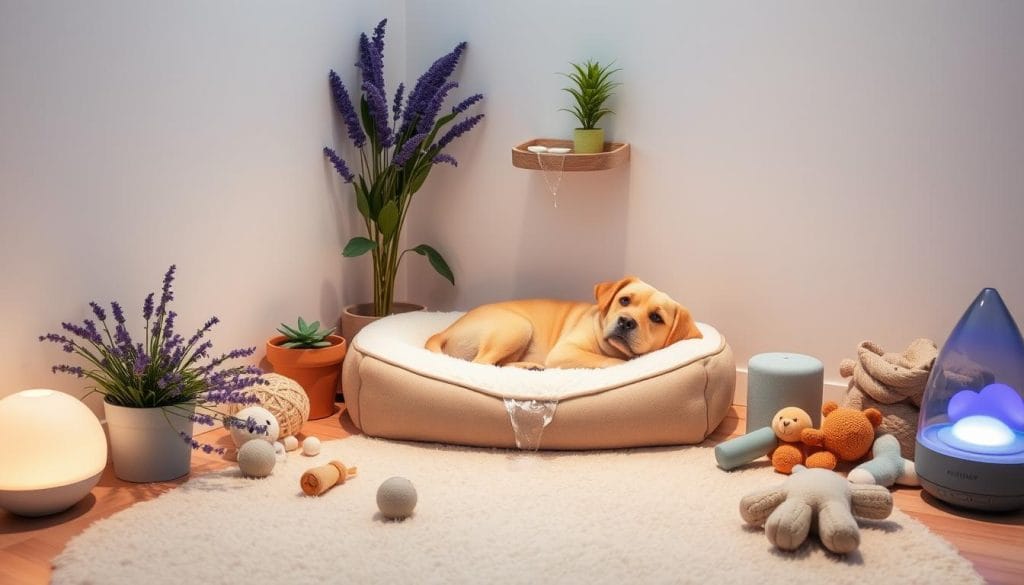Managing stress in pets is key for their happiness. Pets, just like us, can feel anxious or stressed. This can happen due to changes, being away from their owners, or loud sounds. We’ll look at how to help pets relax at home.
We’ll talk about natural remedies, relaxation techniques, and even vet advice. Our goal is to help your pets feel calm and happy. Let’s explore ways to make their home a peaceful place.
Understanding Pet Stress and Anxiety
Recognizing pet anxiety begins with knowing what causes stress in pets. Pets, like people, can feel anxious due to loud noises, being left alone, or changes in their surroundings. By noticing the signs of pet anxiety, you can make your pet feel more comfortable.
Loud noises like thunderstorms or fireworks often stress pets out. They might shake, hide, or bark a lot during these times. Pets also get anxious when left alone, which is known as separation anxiety. It’s important to recognize these signs to care for your pet properly.
Changes in the environment, like moving or getting a new family member, can upset pets too. Signs of anxiety include destructive chewing, being more aggressive, or licking too much. Physical signs are changes in appetite, panting a lot, and odd urination.
Experts say it’s key to watch your pet’s behavior for signs of anxiety. Knowing the signs and causes of pet stress helps you take steps to make your pet’s life better.
The Benefits of Reducing Your Pet’s Stress
Reducing your pet’s stress brings many benefits. It makes them happier and healthier. This leads to better behavior and a more joyful pet.
One key advantage is a stronger immune system. When pets are less stressed, they can fight off illnesses better. This helps them stay healthy for longer.
Stress also affects their digestive health. It can cause stomach problems. But, a relaxed pet has better digestion.
Lastly, reducing stress improves their emotional state. A calm pet is more playful and loving. This strengthens your bond with them.
Natural Remedies for Pet Stress Relief
There are many ways to help pets feel less stressed. You can use herbal remedies, pheromone diffusers, and change their diet. These options can make your pet’s life much better.
Herbal remedies like chamomile and valerian root are great for pets. They help calm pets down. You can give them to your pet in tea or tincture form.
Pheromone diffusers are also very helpful. They release pheromones that tell pets they are safe. Products like Adaptil for dogs and Feliway for cats are highly recommended by holistic vets.
Changing your pet’s diet can also help. Adding omega-3 fatty acids and supplements can reduce anxiety. Brands like Hill’s Prescription Diet have special foods that help pets feel calm.
Using these methods regularly can make your pet’s life stress-free. Always talk to your vet before trying new supplements or foods. This ensures they are safe and work well for your pet.
Using Calming Tools for Pets
Keeping your pet calm and relaxed is key for their happiness. There are many calming tools for pets to help with anxiety and stress. These include calming collars and anxiety wraps, each with special benefits.

Calming collars, with soothing pheromones, can lessen anxiety. They release a scent that feels like a mother’s calming presence. Brands like Adaptil make these collars, which many pet owners find helpful.
Anxiety wraps, like the ThunderShirt, apply gentle pressure. This creates a calming effect, like a hug. They’re great for stressful times, like thunderstorms or fireworks.
Interactive toys, like the Kong Classic Dog Toy, are also useful. They keep your pet’s mind busy and offer stress relief. Playing with these toys can distract them from things that make them anxious.
Pet owners share how well these calm pet products work. They’ve seen big changes in their pets’ behavior and stress levels. It’s smart to try out different calming tools to find what works best for your pet.
Effective Techniques to Calm Your Pet
Several effective techniques can help soothe your pet’s anxiety. Desensitization is one method that works well. It slowly introduces your pet to stressful situations at a pace they can manage. This is often combined with counter-conditioning, where you reward your pet for staying calm when faced with what scares them.
Positive reinforcement training is another great way to calm your pet. It involves rewarding good behavior to encourage it to happen again. This can help your pet see that some situations aren’t as scary as they thought.
Studies show that being consistent is crucial when using these techniques. Regular practice helps your pet become more confident and resilient. Desensitization, in particular, is very effective when done patiently and persistently.
Experts say it’s important to know what specifically scares your pet and tailor your approach to their needs. Whether you’re using desensitization or other calming methods, always watch how your pet reacts. Then, adjust your approach as needed.
Behavioral Training and Its Impact on Pet Anxiety
Behavioral training for pets is more than just teaching commands. It’s a key way to manage anxiety and change unwanted behaviors. With consistent and structured training, you’ll see a big change in your pet’s behavior.
Experts like certified animal behaviorists stress the importance of these training programs. For example, Dr. Sophia Yin’s methods show that training doesn’t just help with obedience. It also greatly reduces anxiety. These practices help your pet feel more in control and less stressed.

There are many training types that work well, like clicker training and positive reinforcement. Desensitization exercises also help. These methods help your pet get used to things that scare them, teaching them how to handle stress. This leads to a big improvement in their happiness and health.
Many pet owners have shared stories of how training has changed their pets for the better. They talk about better behavior and stronger bonds with their pets. By spending time on behavioral training, you’re making your pet’s life happier and healthier.
Pet Massage and Physical Touch Techniques
Using pet massage techniques can calm your furry friend. Physical touch is very soothing for pets, offering comfort and security.
Start in a quiet, safe space. Gently stroke their fur to signal relaxation is coming. Then, use your fingertips for light circular motions on their back and shoulders. This boosts blood flow and relaxes them.
Target areas like the neck and tail base for stress relief. Gentle massage here can ease muscle tension and calm your pet. Physical touch also boosts their mood and reduces stress signs.
Adding relaxation methods to your routine strengthens your bond and benefits your pet’s mental health. Consistency is crucial. Regular massages can greatly improve your pet’s anxiety and stress levels.
Stress Relief for Pets: Techniques and Tools to Calm Your Pet
Understanding the best stress relief for pets means knowing different techniques and tools. You can pick from many pet relaxation methods like aromatherapy, calming music, or a peaceful home environment. Each has its own benefits, but it’s key to find what works best for your pet.
Using essential oils, like lavender, is a popular way to calm pets at home. Soft music or nature sounds can also lower anxiety. Calming gear, such as anxiety wraps or beds, helps create a serene space.

Behavioral training is another great strategy. Positive reinforcement and routines can greatly reduce stress in pets. Toys and interactive games are also great for mental stimulation and stress relief.
By using these pet relaxation methods and considering your pet’s needs, you can create a calm and happy home. Whether it’s aromatherapy, calming music, or training, the aim is to find the best ways to keep your pets relaxed and happy.
The Role of Environmental Changes in Reducing Pet Stress
Creating a pet-friendly environment can greatly reduce pet stress. Whether it’s a new place or a familiar spot, making adjustments can calm your pet. This helps in making your home a peaceful place for them.
Begin by setting up quiet spaces for your pet to relax. A cozy corner with a soft bed and favorite toys is perfect. These areas make your home safe and welcoming for your pet.
Environmental enrichment is also key. Introduce new toys, puzzle feeders, or a cat tree for your feline friends. These activities keep your pets engaged and reduce stress.
Managing sensory stimuli is crucial. Reduce loud noises and chaotic activities. Use calming music or white noise machines for a serene atmosphere. Aromatherapy, especially lavender, can also calm pets.
Lastly, nature is powerful. Adding pet-safe plants beautifies your home and creates a peaceful environment. Small changes can make a big difference in your pet’s comfort and happiness.
The Importance of a Routine for Pet Anxiety Relief
Creating a routine is key to helping your pet feel better mentally. A consistent schedule makes your pet’s world more predictable. This can greatly lessen their anxiety. Veterinary behaviorists say that having a set routine is crucial for your pet’s sense of security.
Having a routine can really help your pet with anxiety. Regular times for meals, exercise, and grooming make your pet’s day better. This routine not only helps with anxiety but also keeps your pet healthy.
A good routine is more than just when to eat. It includes playtime and social activities at the same times every day. Pets like knowing what’s coming next. This can stop them from getting too stressed or acting out.

Vets say sudden changes can make pet anxiety worse. So, keeping a regular schedule is important. It makes your pet feel safer and strengthens your bond. Making a routine a priority is a big step in caring for your pet’s mental health.
Professional Help: When to Consult a Veterinarian
As a pet owner, knowing when your pets need help is key. Home remedies and natural treatments work well, but sometimes, a vet’s advice is needed. A vet can offer insights and solutions you might not see on your own.
When your pet’s stress doesn’t go away, it’s time to see a vet. They can check your pet’s health and find out why they’re stressed. Vets use their knowledge to create treatment plans that fit your pet’s needs.
Vet advice for pet stress might include behavior changes, medical treatments, and changes in their environment. If your pet’s anxiety is serious, don’t wait to get vet help. A vet can make sure your pet gets the care they need for a happier life.
Conclusion
Understanding how to help your pets with stress is key to their happiness. This guide has shown many ways to ease pet anxiety. It’s all about making your furry friend’s life better.
We looked at natural remedies and training methods to calm pets. We also talked about massages, changing their environment, and keeping routines. These steps can make a big difference in your pet’s life.
It’s important to know when to ask for professional help. Regular vet visits are crucial. They help keep your pet’s emotional and physical health in check. A happy pet makes life better for everyone.

